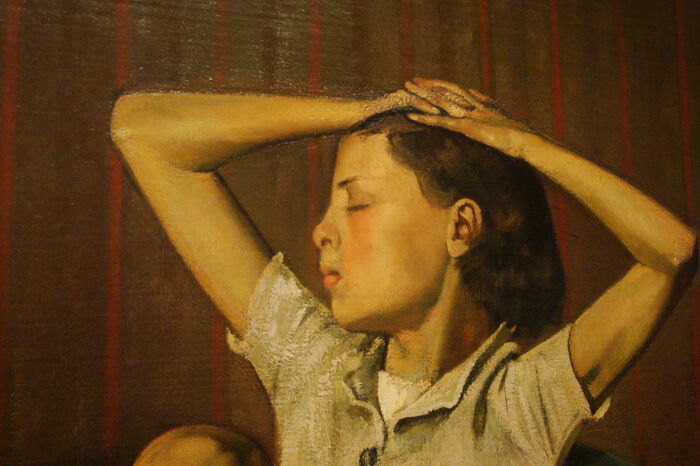Review: Queens’ Arts Festival Exhibition
Ellesheva Kissin reviews the latest Queens’ Arts Festival Exhibition, centred around the theme ‘Hidden’
Cambridge doesn’t have an art degree; that much we all know. The university seems to show a reluctance to lower its high academic standards to what they might refer to as the low level of a degree in art. This deficiency means that events such as the Queens’ Arts Festival are increasingly important, as the student body, as well as its educators, must be reminded that the university should adjust its standards in order to accommodate people from all backgrounds and of all interests.
“Some pieces stood out as being of exceptional quality, either due to their craftsmanship or the often beguiling thought processes behind them”
Walking around the West Gallery, these were the murmurs I heard. Whispers of discontent accompanied the appreciative noises directed at the pieces on display; visitors of the exhibition could not understand why events such as this were the sole artistic outlets for what they spoke of as “highly creative” and “intelligent” young students. The theme for the festival, ‘Hidden’, was a perhaps unintended reference to this uneasy dynamic – the university’s refusal to allow an art degree in effect smothers the ability for many to express themselves artistically. The creative student community is quite literally hidden, with only a few exhibitions a year granting members of this community any legitimation or space in the Cambridge mind.
Creative these students certainly were; the artwork was varied and thoughtful, and displayed a real appreciation for the differing effects of media in expressing meaning. The pieces ranged from oil paintings to screen prints of computer-generated codes, from poetry to boxes of jelly injected with ink, and from satin stitches to lacy underwear. The gallery itself was also beautifully chosen. Lizzie Carr, one of the festival’s directors, describes the gallery as a “hidden space” due to the fact that that it is unheard of by most students. This is true; the ‘gallery’ was a set of nondescript corridors in an anonymous building, beautifully advantaged by its floor-to-ceiling windows, but which nonetheless remains largely undiscovered. The overall experience was pleasing: the pieces were displayed to their full advantage in the floods of sunlight, there was a feeling of escape from daily humdrum into the refuge of a secluded place, and the mix of media kept the viewer engaged.

Some pieces stood out as being of exceptional quality, either due to their craftsmanship or the often beguiling thought processes behind them. One such piece was Hidden?, of anonymous origin. It was a simple idea; a tangle of black thread was placed, front and centre, over a pair of white panties. Some might have thought the piece sensationalist, or perhaps devoted to an overused theme, but to me it displayed just the right balance of attention-grabbing radicalism and sensitivity to the nuances of the topic. The piece forces the viewer to confront female sexuality: a thing so often spoken about, so glorified and so lusted after, yet whose reality is often obscured. The artist herself hid from view, preferring to remain anonymous, and while real lace underwear, a symbol of ‘femininity’ as opposed to what Germaine Greer would call ‘femaleness’ was proudly on display, it was telling that black thread was used in place of pubic hair.
A more abstruse highlight of the exhibition was Oliver Canessa’s Relativistic Millennial Jelly, a piece which attempts to convince the viewer that jelly is dangerous by mimicking the ‘smoking kills’ campaign. Warnings such as “jelly can cause a slow and painful jelly” are combined with close-up shots of a glutinous blood-red jelly-and-glass mixture. It forms a biting satire of the gory images found on cigarette packets, and comments on society’s artificial demonisation of certain forms of behaviour, although in my view it did so perhaps in too obscure a fashion.

Despite the eerie beauty and thoughtfulness of many of the exhibition’s pieces, works such as Relativistic Millennial Jelly – however interesting – revealed a failure to attach the individual works to an overarching theme. The layout of the exhibition was somewhat disappointing: there was little sense of progression of ideas or of groupings of media. The overall effect was of a haphazardly-constructed dish: there were individual flavours that lingered in the mental palate, but it lacked a binding coherence. The theme “Hidden” could have been used more prominently in order to leave the casual visitor with new ideas, but the curators of the exhibition themselves admitted that the theme was difficult to wield, given the “eclectic” mix of art that was submitted.
Events such as Queens’ Arts Festival are crucial in order to give voice to the many artists excluded by Cambridge University’s systemic bias, but while the talent displayed there was promising, the theme so widely publicised and anticipated was a disappointment
 News / Clare Hall spent over £500k opposing busway 24 December 2025
News / Clare Hall spent over £500k opposing busway 24 December 2025 Comment / The ‘class’ of Cambridge24 December 2025
Comment / The ‘class’ of Cambridge24 December 2025 News / Caius mourns its tree-mendous loss23 December 2025
News / Caius mourns its tree-mendous loss23 December 2025 Comment / Yes, I’m brown – but I have more important things to say22 December 2025
Comment / Yes, I’m brown – but I have more important things to say22 December 2025 News / Girton JCR publishes open letter expressing solidarity with Palestine25 December 2025
News / Girton JCR publishes open letter expressing solidarity with Palestine25 December 2025










